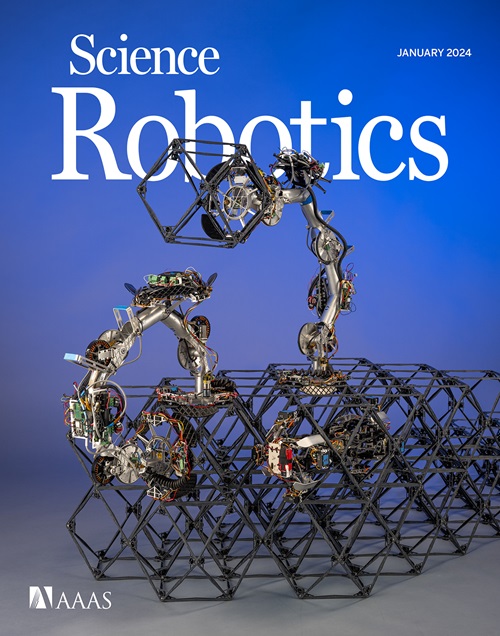自由力:基于视觉的接触力估计与一个柔顺的手
IF 27.5
1区 计算机科学
Q1 ROBOTICS
引用次数: 0
摘要
力感应能力是机器人操作系统必不可少的。然而,常用的腕式力/扭矩传感器笨重、易碎且昂贵,触觉传感器需要在机器人手指上添加易碎的电路,而只能提供触点局部的力信息。在这里,我们提出了一种基于视觉的接触力估计器,它可以作为一种更具成本效益和更容易实现的替代现有的力传感器,通过利用柔顺手在使用柔顺手时接触时的变形。我们的方法使用了一个估计器,它可以直观地观察一个专门的柔性机械手(通过3D打印易于制造的开源工具),并根据其在外力作用下的弹性变形来预测接触力。由于在机器人操作系统中使用腕上摄像机来观察夹持器是常见的,因此我们的方法可以在夹持器是柔性的情况下获得额外的力信息。我们优化了我们的柔顺手,以减少摩擦和避免手指结构中的奇异性,我们在估计器中引入了内存,以对抗剩余摩擦和滞后引起的接触力的部分可观察性。此外,利用视觉基础模型分割出手指,使估计器对背景干扰和手指遮挡具有鲁棒性。虽然它比商用力/扭矩传感器精度低,速度慢,但我们通过实验证明了我们的估计器的准确性和鲁棒性(实现0.2牛顿到0.4牛顿的误差),以及它在各种操作任务中使用夹持器在有噪声背景和遮挡的情况下的实用性。本文章由计算机程序翻译,如有差异,请以英文原文为准。
Forces for free: Vision-based contact force estimation with a compliant hand
Force-sensing capabilities are essential for robot manipulation systems. However, commonly used wrist-mounted force/torque sensors are heavy, fragile, and expensive, and tactile sensors require adding fragile circuitry to the robot fingers while only providing force information local to the contact. Here, we present a vision-based contact force estimator that serves as a more cost-effective and easier-to-implement alternative to existing force sensors by leveraging deformations of compliant hands upon contacts when compliant hands are in use. Our approach uses an estimator that visually observes a specialized compliant robot hand (available open source with easy fabrication through 3D printing) and predicts the contact force on the basis of its elastic deformation upon external forces. Because using wrist-mounted cameras to observe the gripper is common for robot manipulation systems, our method can obtain additional force information provided that the gripper is compliant. We optimized our compliant hand to minimize friction and avoid singularities in finger configurations, and we introduced memory to the estimator to combat the partial observability of the contact forces from the remaining friction and hysteresis. In addition, the estimator was made robust to background distractions and finger occlusions using vision foundation models to segment out the fingers. Although it is less accurate and slower than commercial force/torque sensors, we experimentally demonstrated the accuracy and robustness of our estimator (achieving between 0.2 newton and 0.4 newton error) and its utility during a variety of manipulation tasks using the gripper in the presence of noisy backgrounds and occlusions.
求助全文
通过发布文献求助,成功后即可免费获取论文全文。
去求助
来源期刊

Science Robotics
Mathematics-Control and Optimization
CiteScore
30.60
自引率
2.80%
发文量
83
期刊介绍:
Science Robotics publishes original, peer-reviewed, science- or engineering-based research articles that advance the field of robotics. The journal also features editor-commissioned Reviews. An international team of academic editors holds Science Robotics articles to the same high-quality standard that is the hallmark of the Science family of journals.
Sub-topics include: actuators, advanced materials, artificial Intelligence, autonomous vehicles, bio-inspired design, exoskeletons, fabrication, field robotics, human-robot interaction, humanoids, industrial robotics, kinematics, machine learning, material science, medical technology, motion planning and control, micro- and nano-robotics, multi-robot control, sensors, service robotics, social and ethical issues, soft robotics, and space, planetary and undersea exploration.
 求助内容:
求助内容: 应助结果提醒方式:
应助结果提醒方式:


